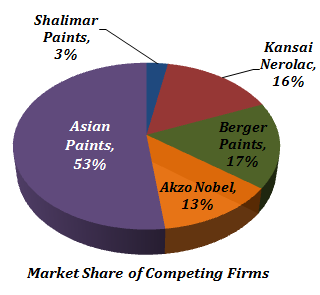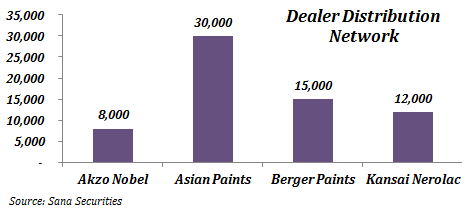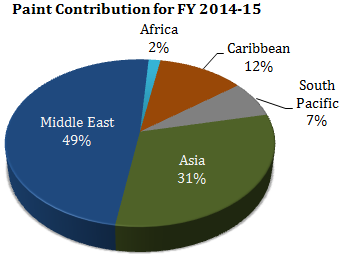Asian Paints Limited (“APL” or the “Company”) operates in Decorative Coatings and Industrial Coatings segments across India and in the geographies of Asia, Middle East, Caribbean and South Pacific Islands through its subsidiaries and joint ventures.
Decorative paints account for over 75% of the overall paint market in India and include wall finishes for interior and exterior use, enamels, wood finishes and ancillary products such as primers, putties, etc.
WHAT’S DRIVING THE STOCK
Strong Financial Position
Asian Paints has shown consistent growth over the last ten years (i.e. 2005-06 to 2014-15). It’s net revenue from operations over this period grew at an impressive CAGR of 17.88 %. For FY 2015, income from operations increased by 11.55 % to Rs. 14,182.81 Cr. from Rs. 12,714.81 Cr. and PAT increased by 13.03 % to Rs. 1,427.33 Cr. from Rs. 1,262.76 Cr. Asian Paints has reserves in excess of Rs. 4,646.44 Cr and operates with negligible debt on its books. This strong financial position not only enables the Company to have bigger marketing and advertising budgets to attract customers; it also enables the Company to expand its operation in a subdued economic environment.
With rising volumes from added capacities and new geographies, and steady margins, earnings could grow significantly in the coming years. A larger dealer network and new products will support growth and an increased focus on luxury products could expand margins.
The Company has maintained an average dividend yield of 0.93 % over the last 5 financial years.
Liquidity and Credit Analysis
Asian Paint’s average current ratio over the last 5 financial years has been 1.43 times which indicates that the Company is comfortably placed to pay for its short term obligations.
Asian Paint’s average long term debt equity ratio over the 5 financial years has been 0.02 times which indicates that the Company operates with close to zero debt and is placed well to withstand economic slowdowns.
Asian Paint’s average interest coverage ratio over the last 5 financial years has been 50.96 times this indicates that the Company can meet its debt obligations without any difficulty.
Dominant Market Position
Asian Paints is India’s largest paint company and ranked among the top ten decorative coatings companies in the world with a turnover of Rs. 96.32 billion. The Company is currently a market leader in the Indian paints industry with about 53 % market share.The group operates in five regions across the world viz. South Asia, South East Asia (31%), South Pacific (7.0 %), Middle East (48.6 %) and Caribbean region (11.8 %) through the five corporate brands viz. Asian Paints, Berger International, SCIB Paints, Apco Coatings and Taubmans.

Retail Network & Distribution
Asian paints has the strongest retail network and distribution infrastructure among its competitors which helps the Company in higher penetration levels spread across urban and rural areas. The Company expects to add 1,500-2,000 new dealers every year to its already enviable network of ~30,000 dealers. Continuous efforts into dealer development programs and focus on the customer enable the Company to build a robust infrastructure network further reducing any threats from competitors.

Currently, the total installed paints capacity stands at 6, 44,000 KL. Asian Paints is focusing on building strengths for the future and continues to invest in building capabilities. The Company’s planning on capacity building for the future is well on track. The Company’s has initiated to double its capacity at Rohtak plant in Haryana from the existing 2,00,000 KL per annum to 4,00,000 KL per annum by FY 2016.
Further, in order to meet the demand in the southern and eastern parts of the country, Asian Paints is looking to set up paint manufacturing facilities in the states of Karnataka and Andhra Pradesh. The maximum capacity of the proposed manufacturing facility at Visakhapatnam, Andhra Pradesh would be 4,00,000 KL per annum
WHAT’s DRAGGING THE STOCK
Increasing competition
Entry of new foreign players like Nippon, Sherwin Williams and National Paints; and aggressive capacity addition by existing players indicates increasing competitive intensity. However, Asian Paints has been able to not only protect its market share but continuously increasing it with aggressive market strategies and by anticipating early the next growing trend in the industry.
Demand slowdown in various sectors
The Paint market in India during the last 12-18 months witnessed a slowdown. A slowdown in discretionary consumption affects Asian Paints decorative paints business, while a weaker growth in industries like automobile, manufacturing, infrastructure directly impacts the demand for industrial paint. Demand for decorative paints which accounts for nearly 70 % of Asian Paint’s total sales depend upon housing and real estate sector, which are showing signs of a slowdown.
______________________
** The stock analysis of Asian Paints including the financial analysis report linked above, is for informational purpose only. This analysis should not be taken as a buy/sell recommendation. The circumstances of the company and the economic environment may have changed since the date of this stock analysis


